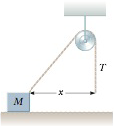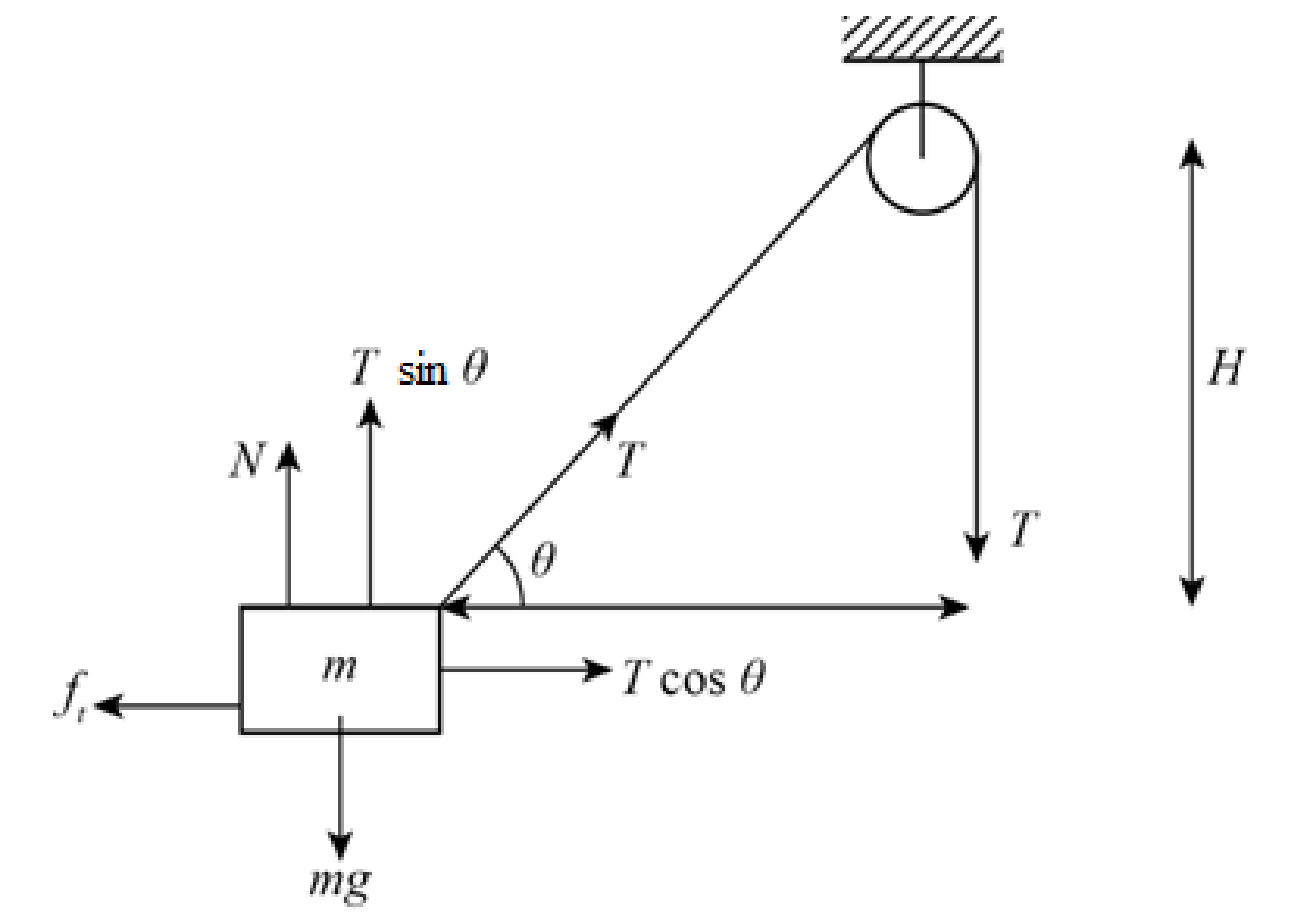
Concept explainers
A block of mass 2.20 kg is accelerated across a rough surface by a light cord passing over a small pulley as shown in Figure P5.51. The tension T in the cord is maintained at 10.0 N, and the pulley is 0.100 m above the top of the block. The coefficient of kinetic friction is 0.400. (a) Determine the acceleration of the block when x = 0.400 m. (b) Describe the general behavior of the acceleration as the block slides from a location where x is large to x = 0. (c) Find the maximum value of the acceleration and the position x for which it occurs. (d) Find the value of x for which the acceleration is zero.
Figure P5.51

(a)
The acceleration of the block when
Answer to Problem 51CP
The acceleration of the block when
Explanation of Solution
The mass of block is
Consider the free body diagram give below.

Figure I
Write the expression for the angle the block makes with the pulley
Here,
Substitute
Write the formula to calculate normal reaction
Here,
Substitute
The equation for the force in x direction
Here,
Conclusion:
Substitute
Therefore, the acceleration of the block when
(b)
The general behavior of the acceleration as the block slides from a location where
Answer to Problem 51CP
The acceleration increases initially then decreases and becomes negative as the value of
Explanation of Solution
Substitute
Substitute
Substitute
Substitute
When
Conclusion:
Therefore, the acceleration increases initially then decreases and becomes negative as the value of
(c)
The maximum value of the acceleration and its corresponding position.
Answer to Problem 51CP
The maximum value of the acceleration is
Explanation of Solution
Differentiate the equation (IV) with respect to
Further solve for
Substitute
Rearrange (I) for
Substitute
Conclusion:
Therefore, the maximum value of the acceleration is
(d)
The position where acceleration is zero.
Answer to Problem 51CP
The acceleration is zero at the position
Explanation of Solution
Substitute
Substitute
Conclusion:
Substitute
Solving the above expression for
Therefore, the position
Want to see more full solutions like this?
Chapter 5 Solutions
PHYSICS FOR SCIENCE & ENGINEERS
- In Figure P4.53, the incline has mass M and is fastened to the stationary horizontal tabletop. The block of mass m is placed near the bottom of the incline and is released with a quick push that sets it sliding upward. The block stops near the top of the incline as shown in the figure and then slides down again, always without friction. Find the force that the tabletop exerts on the incline throughout this motion in terms of m, M, g, and .arrow_forwardConsider the three connected objects shown in Figure P5.43. Assume first that the inclined plane is frictionless and that the system is in equilibrium. In terms of m, g, and , find (a) the mass M and (b) the tensions T1 and T2. Now assume that the value of M is double the value found in part (a). Find (c) the acceleration of each object and (d) the tensions T1 and T2. Next, assume that the coefficient of static friction between m and 2m and the inclined plane is s and that the system is in equilibrium. Find (e) the maximum value of M and (f) the minimum value of M. (g) Compare the values of T2 when M has its minimum and maximum values. Figure P5.43arrow_forwardA car weighing 1202kg accelerates from a stop to 100km/hr in 4.3 sec going up a ramp at an angle of 22 degrees from the x axis. given drag and friction are negligible due to the car's sick aerodynamics, what is total force in the forward direction?arrow_forward
- In the system shown in Figure P5.23, a horizontal force Facts on an object of mass m2 = 8.00 kg . The horizontal surface is frictionless. Consider the acceleration of the sliding object as a function of F. (a) For what values of F, does the object of mass m = 2.00 kg accelerate upward? Answer! (b) For what values of F, is the tension in the cord zero? Answer! () Plot the acceleration of the m, object versus F. Include values of F, from - 100 N to +100 N. SNIPParrow_forwardA man is driving his SUV with speed 51.0 mi/h on a horizontal stretch of road. (a) When the road is wet, the coefficient of static friction between the road and the tires is 0.104. Find the minimum stopping distance (in m). m (b) When the road is dry, μs = 0.596. Find the minimum stopping distance (in m). marrow_forwardAt the airport, you pull a 12kg suitcase across the floor with a strap that is at an angle of 35 degrees above the horizontal. Find the magnitude of the tension in the strap, given that the suitcase moves with a constant speed and the coefficient of kinetic friction between the suitcase and floor is 0.33.arrow_forward
- During a military training in Camp Jizmundo, Libas, Banga, Aklan , a sky diver of weighing 82 kg ( including equipment ) falls vertically downward from an altitude of 1500 meters, and opens the parachute after 10 sec of free fall. Assume that the force of air resistance is proportional to velocity. The air drag coefficient before opening the chute is k1 = 1.65 kg/sec , when the parachute is closed and after opening the chute k2 = 26.4 kg/sec.Take g = 9.8 m/s 2 . (a) Find the speed of the sky diver when the parachute opens ? (b) Find the distance fallen before the parachute opens.arrow_forwardA cougar bites a llama of mass m and drags it across some rough horizontal ground. The cougar applies a horizontal force of magnitude F, and the llama is dragged at a constant velocity. The coefficient of kinetic friction is μk. While the cougar applies the force F, the magnitude of the kinetic friction force, fk , on the llama obeys: a)F > µk m g > fk b)F = fk = µk m gc)F = fk < µk m gd)cannot answer, not enough information givene) F > fk = µk m garrow_forwardA cake rests in a cardboard box on the horizontal surface of the seat of your car which is traveling at 11 m/s. If the coefficients of friction are µk = 0.3 and µs = 0.5, find the minimum stopping distance necessary to keep the cake box from sliding off the seat.arrow_forward
- A car has a mass of 1750 kg. If the driver applies the brakes while on a gravel road, the maximum friction force that the tires can provide without skidding is about 6500 N. If the car is moving at 22 m/s, what is the shortest distance in which the car can stop safely?arrow_forwardA city is trying to determine the speed limit for a given stretch of road. If a stop sign is visible from 62.0m on a straight, horizontal stretch of road and the coefficient of static friction between the road and the tires of a car is 0.525 then what is the maximum speed for a car in meters per second so that it can come to a complete stop at the stop sign?arrow_forwardA 5.00 kg box sits at rest at the bottom of a ramp that is 8.00 m long and is inclined at 30 degrees above the horizontal. The coefficent of kinetic friction between the box and the surface is 0.40, and coefficent of static friction is 0.43. What constant force F, applied parallel to the surface of the ramp, is required to push the box to the top of the ramp in a time of 6.00 seconds?arrow_forward
 Principles of Physics: A Calculus-Based TextPhysicsISBN:9781133104261Author:Raymond A. Serway, John W. JewettPublisher:Cengage Learning
Principles of Physics: A Calculus-Based TextPhysicsISBN:9781133104261Author:Raymond A. Serway, John W. JewettPublisher:Cengage Learning Physics for Scientists and Engineers: Foundations...PhysicsISBN:9781133939146Author:Katz, Debora M.Publisher:Cengage Learning
Physics for Scientists and Engineers: Foundations...PhysicsISBN:9781133939146Author:Katz, Debora M.Publisher:Cengage Learning

